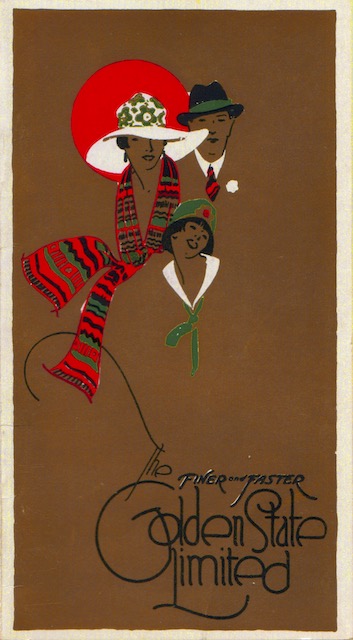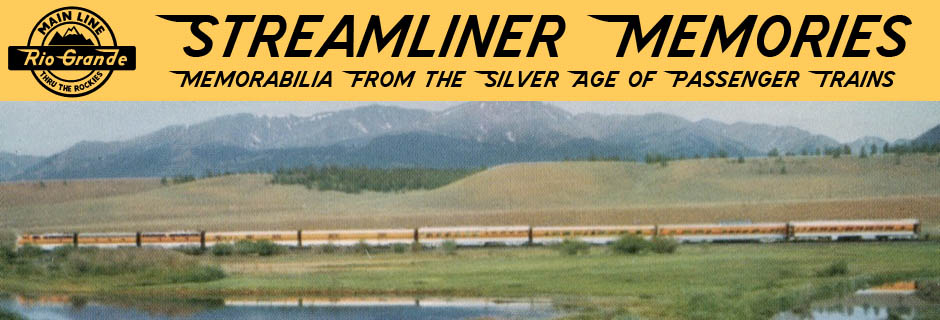As previously noted, in November, 1926, the three sets of railroads competing in the Chicago-Los Angeles market had reduced the schedules of their premiere trains from 68 to 63 hours. Riding any of these trains required a $10 extra fare, about $170 in today’s money. In 1928, they reduced times again to 61-1/4 hours. But then in 1929, the Santa Fe reduced the time of the Chief to 58 hours each way. Unable to keep up, Union Pacific and Southern Pacific-Rock Island stayed on the 1928 schedules and dropped their extra fares.
 Click image to download a 2.3-MB PDF of this 16-page booklet.
Click image to download a 2.3-MB PDF of this 16-page booklet.
This was the situation in March, 1936, when Rock Island published this booklet advertising the Golden State Limited. Unable to compete on time, the booklet emphasizes the “de luxe” aspects of the train: the “perfectly-appointed dining car”; the club car featuring “market reports and late news items direct by telegraph”; the ladies maid-manicurist; the barber-valet; the men’s and women’s showers; the library; and the “new-type observation sun-parlor.” These are illustrated by drawings of people wearing the latest fashions for the upper-middle class.
Underscoring the de luxe nature of the train, the type face used for the words “Golden State Limited” on the booklet cover and repeated on pages 3 and 4 is a variation of an art deco lettering style that came out of a 1922 book called Basic Lettering by Walter Heberling. Though this book should be out of copyright, no one appears to have digitized it, and copies sell for $100 or more, so I don’t know if the type face in this booklet is closer to what is in the Heberling’s book than the modern digital typeface known as Heberling Casual.
In any case, the Golden State would suffer another setback just two months after this booklet was published, for on May 15, 1936, Union Pacific introduced the City of Los Angeles on a 39-3/4 hour schedule. This was 18 hours faster than the Chief and more than 21 hours faster than the Golden State.
Santa Fe answered this challenge a year later when it introduced the Super Chief on the same 39-3/4 hour schedule. Southern Pacific and Rock Island, however, were never able to match that. This booklet was able to say that the Golden State was the fastest train between Chicago and Phoenix, but at the time Phoenix was a town of only about 60,000 residents.
Not all print colors can be reproduced on screens. The cover of this booklet is meant to have a golden sheen, thus emphasizing the de luxe nature of the train. Unfortunately, it reproduces on the screen as brown.

While the Golden State could not compete against the Super Chief or COLA on the basis of speed, its schedule mirrored that of the Chief for several years after the war, which suggests that SP viewed the Chief as its real competition, not the other two. And SP had something to sell that the other two didn’t: warm winter weather along the way at intermediate stops like Tucson, Phoenix, and Palm Springs. IIRC, there were set out sleepers at Phoenix in both directions.
SP had an arrangement with T & P for a Dallas sleeping car on the Sunset. Just spit balling here, why didn’t they have through car service to St. Louis via Mo Pac as well? Now, most people would look at a LA – St. Louis schedule like that and say “too slow, can’t compete with the City of St. Louis.” But keep in mind that even in those days most trips were between intermediate stations, not end point to end point, so a passenger wishing to travel, let’s say, from Tucson to St. Louis would have had an option.